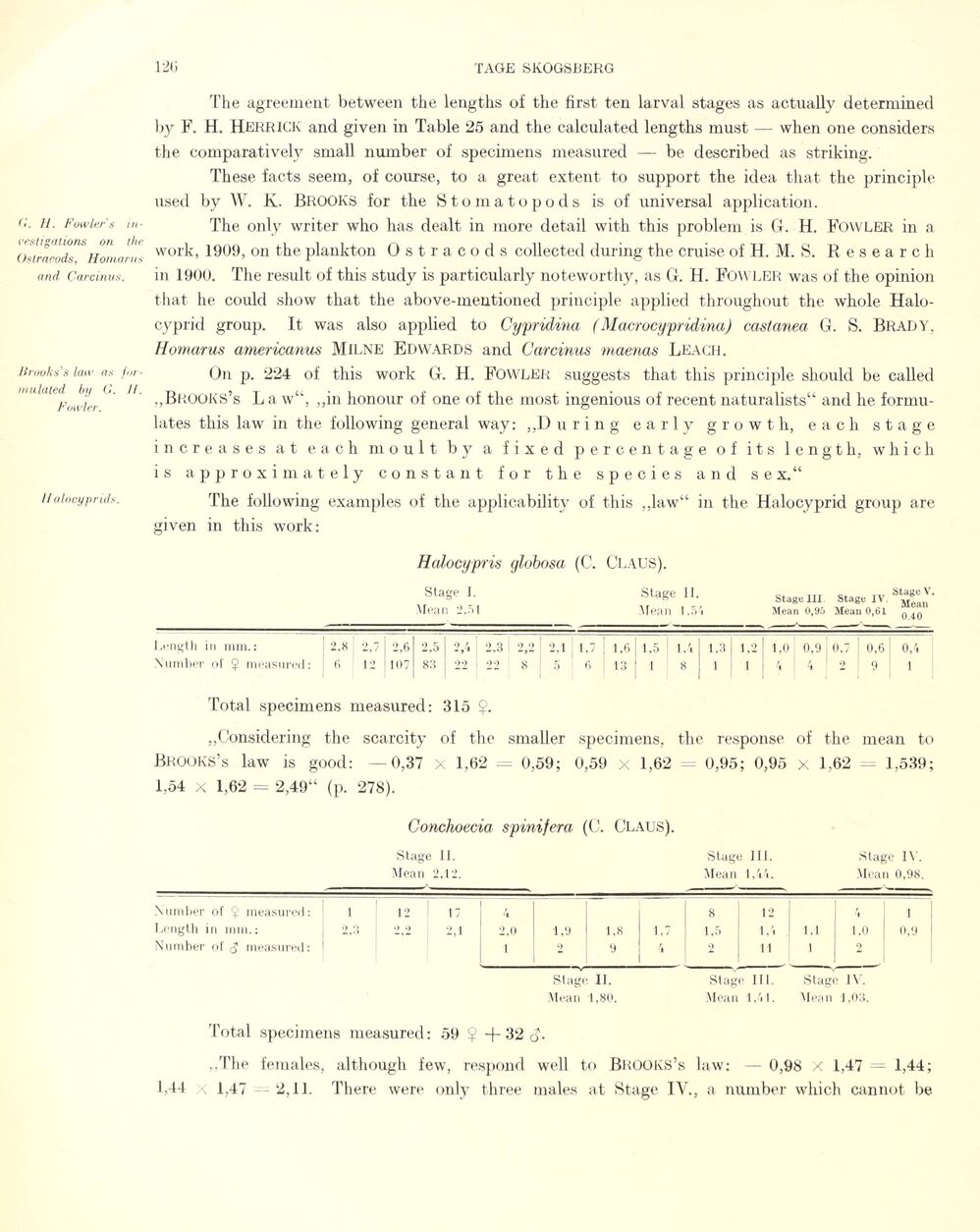
Full resolution (JPEG) - On this page / på denna sida - Sidor ...

<< prev. page << föreg. sida << >> nästa sida >> next page >>
Below is the raw OCR text
from the above scanned image.
Do you see an error? Proofread the page now!
Här nedan syns maskintolkade texten från faksimilbilden ovan.
Ser du något fel? Korrekturläs sidan nu!
This page has never been proofread. / Denna sida har aldrig korrekturlästs.
G. H. Fowler’s
in-vesligalions on the
Oslracods, H omar ns
and Carcinus.
lirouks’s law as
/«/■-mulaled by G. II.
Fowler.
H alocyprids.
The agreement between the lengths of the first ten larval stages as actually determined
by F. H. HERRICK and given in Table 25 and the calculated lengths must — when one considers
the comparatively small number of specimens measured — be described as striking.
These facts seem, of course, to a great extent to support the idea that the principle
used by W. K. BROOKS for the S to ma to pod s is of universal application.
The only weiter who has dealt in more detail with this problem is G. H. Fowler in a
work, 1909, on the plankton Ostracods collected during the cruise of H. M. S. Research
in 1900. The result of this study is particularly noteworthy, as G. H. FOWLER was of the opinion
that he could show that the above-mentioned principle applied throughout the whole
Halo-cyprid group. It was also applied to Cypridina (Macrocypridina) castanea G. S. Brady,
Homarus americanus Milne Edwards and Carcinus maenas Lea ch.
On p. 224 of this work G. H. FOWLER suggests that this principle should be called
„BROOKS’s L a wu, „in honour of one of the most ingenious of recent naturalists“ and he
formulâtes this law in the following general way: ,,D uring early g r o w t h, each stage
increases at each moult by a fixed perce n tage of its length, which
is approximately constant for the species and sex.“
The following examples of the applicability of this „law“ in the Halocyprid group are
given in this work:
Halocypris globosa (C. Claus).
Stage I. Mean 2,51 Stage II. Mean 1,5 Stage III Stage IV. • i Mean 0,95 Mean 0,61 Q 4q
Length in mm.: \umber of $ measured: 1 2,8 2,7 2,6 6 12 107 2.5 2,4 2.3 2,2 ’ 2,1 83 22 22 8 5 1,7 ; 1,6 1,5 1 1.4 6 13 ; 1 8 1 1 1,3 1,2 1,0 0,9 0,7 1 0,6 1 0,4 1 1 4 4 2 9 1
Total specimens measured: 315 Ç.
„Considering the scarcity of the smaller specimens, the response of the mean to
BROOKS’s law is good: —0,37 X 1,62 — 0,59; 0,59 X 1,62 — 0,95; 0,95 X 1,62 = 1,539;
1,54 X 1,62 = 2,49“ (p. 278).
Gonchoecia spinifera (C. Claus).
Stage II. Stage III. Stage IV.
Mean 2,12. Mean 1,44. Mean 0,98.
Number of Ç measured: 1 12 17 4 8 12 4 i
Length in mm.: 2,3 2,2 1 2,1 2,0 1,9 1,8 1,7 1.5 1.4 1,1 1,0 0,9
Number of measured: 1 9 9 4 2 11 12 A ‘
Stage IL Stage III. Stage IV.
Mean 1,80. Mean 1,41. Mean 1,03.
Total specimens measured: 59 Ç -f- 32
„The females, although few, respond well to BROOKS’s law: — 0,98 x 1,47 = 1,44;
1,44 x 1,47 – 2,11. There were only three males at Stage IV., a number which cannot be
<< prev. page << föreg. sida << >> nästa sida >> next page >>